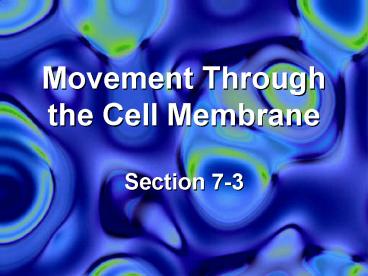Movement Through the Cell Membrane - PowerPoint PPT Presentation
1 / 23
Title:
Movement Through the Cell Membrane
Description:
The cell membrane regulates what enters and leaves the ... Lipid Bilayer ... of nearly all cell membranes is a double-layered sheet called the lipid bilayer. ... – PowerPoint PPT presentation
Number of Views:46
Avg rating:3.0/5.0
Title: Movement Through the Cell Membrane
1
Movement Through the Cell Membrane
- Section 7-3
2
(No Transcript)
3
Cell Membrane
- Just like a country has borders, so does a cell.
- The boundary of a cell is the cell membrane.
4
- The cell membrane regulates what enters and
leaves the cell and also provides protection and
support. - Takes in food and water
- Eliminates waste
5
Lipid Bilayer
- The core of nearly all cell membranes is a
double-layered sheet called the lipid bilayer. - Gives the cell membrane a tough and flexible
structure that forms a strong barrier between the
cell and its surroundings.
6
Proteins
- Most cell membranes contain protein molecules
that run through the cell membrane.
7
Carbohydrates
- Carbohydrate molecules form chains that are
attached to the outer surfaces of these proteins. - Act like chemical identification cards allowing
cells to identify each other.
8
Mosaic
- What is a mosaic?
9
Cell Membrane Mosaic
- There are so many kinds of molecules attached to
most membranes that scientists call the membrane
a mosaic of different molecules. - Fluid Mosaic Model
- Proteins
- Carbohydrates
- Lipids
- Cholesterol
10
Diffusion
- Every living cell is full of water and surrounded
by water. - Diffusion Molecules moving from an area of high
concentration to an area of low concentration. - Concentration The mass of solute in a given
volume of solution, or mass/volume.
11
Examples of Diffusion
- Perfume
Further spreading of molecules carries the
perfume molecules to the middle of the classroom
and finally to the back of the room. See Figure
2.3 below. Figure2.3
Perfume Molecules Spreading
Out in Classroom Eventually the perfume
molecules are evenly intermixed with the
nitrogen, oxygen and carbon dioxide molecules of
the air such that one liter of air from the front
of the room would contain the same number of
perfume molecules as a liter of air from the back
of the room.
12
Examples of Diffusion
- Food Coloring in water
13
Equilibrium
- When the concentration of solute is the same
throughout a solution, the system has reached
equilibrium. - Many substances move across the cell membrane,
but the cell DOES NOT USE ENERGY!!
14
Osmosis
- Not all substances can cross cell membranes.
- Osmosis allows water molecules to pass easily
through most cell membranes. - Osmosis Diffusion of water across a selectively
permeable membrane.
15
Selectively Permeable Membrane
- Cell membranes that some substances can pass
across but others cannot.
16
Osmosis
- Only water can cross the cell membrane!
- Water will move from areas of high concentration
to areas of low concentration! - It will do this until equilibrium is reached.
17
- Salt is a solute, when it is concentrated inside
or outside the cell, it will draw the water in
its direction. This is also why you get thirsty
after eating something salty.
18
(No Transcript)
19
Osmotic Pressure
- Isotonic Solution When the concentration of
water and solutes is the same inside the cell as
outside the cell.
20
Osmotic Pressure
- Hypertonic Solution If the concentration of
solutes is greater outside the cell than inside
the cell.
Cell Shrinks!
21
Osmotic Pressure
- Hypotonic Solution When the solutes inside the
cell are greater than outside the cell.
Cell Bursts!
22
Facilitated Diffusion
- Facilitated Diffusion a process whereby a
substance passes through a membrane with the help
of a facilitator. - Protein channels allow ions, salts, sugars to
cross the membrane.
23
Active Transport
- Some solutes have a higher concentration inside
the cell than outside so they have to cross the
membrane against the concentration gradient. - We call it active because it requires energy from
the cell. - Ex Endocytosis and Exocytosis

